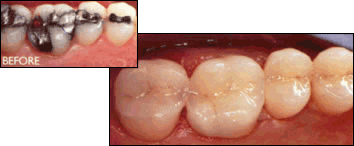Treating Cavities with Tooth-Colored Fillings
August 13, 2013
 At some point, nearly everyone will get a cavity. When that happens, we hope you’ll turn to Dr. Jeff Nichols and his team at Premier Walk-In Dental for help. At our Rockledge dental office, we offer tooth-colored fillings to help patients treat decay discreetly.
At some point, nearly everyone will get a cavity. When that happens, we hope you’ll turn to Dr. Jeff Nichols and his team at Premier Walk-In Dental for help. At our Rockledge dental office, we offer tooth-colored fillings to help patients treat decay discreetly.
For many years, amalgam fillings were the treatment of choice by dentists. But today, dentist like Dr. Jeff Nichols are more likely to offer tooth-colored fillings, in part because of how well they blend in with the color of teeth.
However, there are other reasons that dentist are offering tooth-colored fillings over amalgam fillings. First, amalgam fillings are made of metal, which expands and contracts, causing cracks or leaks and putting the patient at risk of bacterial reinvasion. Second, amalgam fillings often contain a small amount of mercury—not enough to be harmful, but it’s there nonetheless.
Tooth-colored fillings, by comparison, don’t contain mercury and, in fact, aren’t made of metal at all. That also means they won’t expand or contract. As a result, they’re more supportive of the tooth’s natural structure, which means you get to keep more of your natural smile.
Do you need help treating a cavity with a tooth-colored filling? Call or visit Premier Walk-In Dental in Rockledge today. We serve patients from Cocoa, Satellite Beach, Merritt Island, Viera, Suntree, Melbourne, and Palm Bay, Florida.
What Causes Tooth Pain?
July 8, 2013
 Every day, your local dentist is helping patient overcome tooth pain. How they’re doing that depends on what is causing the pain in the first place, though.
Every day, your local dentist is helping patient overcome tooth pain. How they’re doing that depends on what is causing the pain in the first place, though.
Tooth pain has a variety of causes, with cavities being one of the primary examples. Cavities are the result of decay, which is itself the result of demineralization. Here’s how the demineralization process works.
First, certain kinds of bacteria in the mouth come into contact with sugar or another carbohydrate. Those selected bacterium begin to feed on that carb, creating an acidic byproduct. Both cling to teeth, eating away at the protective outer layer known as the enamel. If the demineralization process continues, small holes will form in teeth, exposing the sensitive inner layers of dentin and the nerve.
With tooth sensitivity, the situation is similar though the cause is different. Often, tooth sensitivity occurs where the gums have receded, exposing part of the tooth’s root. Here there is little to no enamel, meaning that the hot or cold foods and drinks you consume are likely to come into contact with the porous layer of dentin and the nerve underneath.
In other cases, pain may be caused by a tooth that is cracked, chipped, or has developed an abscess.
So, how will your doctor treat your pain?
In the case of a cavity, a simple filling will help restore good health and functionality. For a tooth that’s broken or badly decayed, a crown may be the best solution. Other patients may need to have their pain treated with a root canal.
Do you struggle with tooth pain on a daily basis? Call your local dentist for a consultation. Your doctor will talk to you about your situation and recommend a treatment that will help you achieve optimal oral health.
What Is Tooth Decay and What Causes It?
May 24, 2013
 If you ask someone if sugar causes cavities, there’s a good chance they’ll say yes. This isn’t really the whole story, though. Sugar does contribute to problems with oral health, but the cause isn’t so direct as at. What really causes decay is acid, which then weakens the tooth’s outer layer, known as enamel.
If you ask someone if sugar causes cavities, there’s a good chance they’ll say yes. This isn’t really the whole story, though. Sugar does contribute to problems with oral health, but the cause isn’t so direct as at. What really causes decay is acid, which then weakens the tooth’s outer layer, known as enamel.
Where does that acid come from?
From the interaction of bacteria with food, including, yes, foods that are high in sugar. When bacteria accumulate, it becomes a sticky substance known as plaque, which can then harden into calculus. The process, and the damage it can do to teeth, can be held at bay with an oral health regimen that includes brushing, flossing, and regular visit to your local dentist. Including an antibacterial or fluoride mouthwash can also help.
In cases where a tooth has started to decay or weaken as a result of acid, treatment is completed with a simple filling procedure. During a filling procedure, the decay is removed from a tooth and replaced with a strong, durable material like composite resin. The other benefit of composite resin, besides its strength, is that it can easily blend in with teeth, making your fillings nearly invisible.
To learn more about tooth-colored fillings, talk to your local dentist about how they work and if they’re right for your situation.

